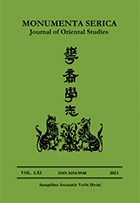
文史研究院“亚洲宗教、艺术与历史研究”专业博士生李鸿坤(Bony Schachter)的论文《〈高上玉皇本行集经〉第一品译注》发表在国际汉学界的重要期刊《华裔学志》(MONUMENTA SERICA)第62卷第一号,2014年12月。另有《帝王隐喻之外:由社会史的角度看〈高上玉皇本行集经〉的内容和接受史》一文,发表在香港中文大学《中国文化研究所学报》(英文, Journal of Chinese Studies)第60卷,2015年1月。
《高上玉皇本行集经》第一品译注
李鸿坤(Bony Schachter)
[摘要] 本文讨论《高上玉皇本行集经》的结构和内容,并提供该道经第一品的译注。第一部分主要介绍“玉皇”的简史,指出六朝时期文献中“玉皇”一词可代表若干不同的神灵,而自宋朝以来,作为诸神之主的“玉皇”,在不同的文献的语境中,逐渐展现出一种多元化的特征。第二部分讨论《高上玉皇本行集经》的接受史,并强调所谓的“扶乩”仪式在阐释该道经的过程中所扮演的角色。通过译本所提供的注释,论文试图将《高上玉皇本行集经》的文献脉络加以梳理,并在附录中明确指出该道经的不同文献层面的来源和年代。
GAOSHANG YUHUANG BENXING JIJING (COMBINED SCRIPTURES OF THE ORIGINAL ACTS OF THE EXALTED AND SUPERIOR JADE SOVEREIGN) AN ANNOTATED TRANSLATION AND STUDY OF ITS FIRST CHAPTER
BONY SCHACHTER
Introduction
The Gaoshang Yuhuang benxing jijing 高上玉皇本行集經 (CT 10 and CT 11, Combined scriptures of the Original Acts of the Exalted and Superior Jade Sovereign; hereafter: YHJ) is the sole work of the Ming Daoist Canon devoted to the deity referred to by the title of the scripture. The YHJ is divided into three juan 卷 and five chapters. The first juan is formed by the first chapter. The second and the third juan comprise two chapters each. The first juan can be understood as an iconographical and hagiographical description of the Jade Thearch. The second juan praises the Perfected Writs (zhenwen 真文) of the Lingbao 靈寶 revelation and the merit of the Heavenly Thearch as its transmitter. The third juan exalts the benefits brought by recitation of the scripture and describes the penalties for improper attitudes against it. Our text narrates the story of the encounter of the Jade Thearch with a sacred assembly in the Pure Tenuity Heaven (qingweitian 清微天). There he manifests six powers and liberates his light throughout the world-systems of the ten directions.
……
This article can be divided into three parts. The first part discusses briefly the contributions of previous scholars and the evolving complexity of the Jade Sovereign’s identity throughout a selection of sources extending from the Six Dynasties to Qing times. This part deals with how different groups in Chinese society have formed their own images of the Jade Sovereign throughout history. The second part is dedicated to the problem of the scriptural reception. Hsieh Tsung-hui (Xie Conghui 謝聰輝) has demonstrated convincingly the relationship between the final redaction of the YHJ and the mediumistic cult of Zitong in the Sichuan area. Following his approach, I shall demonstrate the importance of this kind of ritual throughout the history of our scripture’s reception from the period of the Song to the 20th century. In the last part of this article, I would like to discuss – by means of the annotations accompanying the translation – what the choices related to the sources of the first chapter of the text, with its scriptural structure and content, might suggest in terms of the religious purpose and intended audience for our document.
帝王隐喻之外:由社会史的角度看《高上玉皇本行集经》的内容和接受史
Beyond the Kingly Metaphor: A Sociological Reading of the Scripture of the Jade Sovereign
Bony Schachter
Fudan University
[提要] 本文初步探讨了《高上玉皇本行集经》的内容与接受史。目前,有关《高上玉皇本行集经》的探讨,局限于成书年代和问世背景的问题。据今人的考证,《高上玉皇本行集经》属于南宋、七曲山文昌崇拜的道经,其最早版本应是1218年、以金人侵入四川为历史背景的版本。本文主张《高上玉皇本行集经》的内容是值得进一步探讨的课题。本文详细分析该道经的内容,指出它是为了满足不同社会群体的需要而设计的。《高上玉皇本行集经》内容主要涉及若干承诺和威胁,以及基于这些承诺和威胁所主张的各种仪式化的行为(ritualized behaviours)。《高上玉皇本行集经》里所描述的仪式化的行为,建立起宗教经典的使用者(scriptural user)与宗教文本之间的关系,而历代的编者通过各种灵验故事来强调或否定这种关系的可靠性和神圣性。笔者介绍了非道教读者对《高上玉皇本行集经》所做出的种种反应。据笔者的考证,道教、佛教、天主教各种文献指出,明清以来,玉皇的身份曾经变成为各方激烈争论的对象:佛教徒认为玉皇只不过是帝释天的化身;道教徒认为玉皇既可以理解为燃灯佛,又可以视为儒教祀典中的昊天、上帝等神灵,但绝不能与帝释天等同;天主教徒则坚决反对“玉皇为耶稣、玉皇为神”之说。从《高上玉皇本行集经》的接受史也可以看出,在明清时期,该道经曾遭遇到佛教界和在华天主教界的严厉批评。本文拟解释这些冲突的原因所在,并且提出这些冲突与《高上玉皇本行集经》的论点之间有密切的关系。
[关键词] 宗教 仪式 道教 玉皇 《玉皇经》
Keywords: religion ritual Daoism Jade Sovereign Scripture of the Jade Sovereign